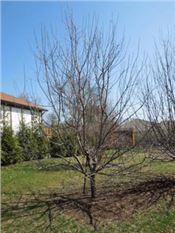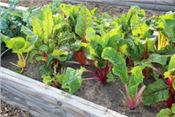Gardening Page
Preventing Fruit Tree Diseases Starts In The Dormant Season

Prevent diseases in fruit trees starts in the winter during the dormant season before plants like this apple tree sprout leaves.
Photo credit Ken Johnson
ANDREW HOLSINGER
URBANA, ILLINOIS
Winter is a great time for orchard owners and fruit tree gardeners to reflect on how their trees are doing and to create a plan for the coming growing season.
When it comes to disease possibilities, tracking seasonal successes and failures helps in the long term.
Keeping a journal of activities of management and care is essential in caring for fruit trees. Using a spray guide provides a reference based on the disease and physiological state of the tree.
The most effective way to care for tree fruit diseases is for both commercial and homeowner level gardeners to know when to spray fungicides and herbicides. Often, a tree is infected long before symptoms are observed and prevention is key to tree health, especially with fungal diseases. Fungicide needs to be applied and reapplied to keep trees protected throughout the season.
Some sprays can only be applied in late winter and early spring to prevent disease before the leaves have emerged. Diseases often develop because a spray wasn’t applied.
Peach leaf curl is an example of a disease that can easily be avoided by spraying during the dormant season.
Fruit tree disease prevent starts early by choosing disease resistant varieties. Only plant top quality, healthy nursery stock to avoid failure. Trees that are stressed are more susceptible to disease and insect pressures. Controlling insects and other pests is important because any wound on trees or fruit is a possible entry point for pathogens.
These apple varieties have disease resistant characteristics and are good options for Illinois landscapes or orchards: Crimson Crisp, Dayton, Enterprise, Freedom, Golden Delicious, Gold Rush, Jonafree, Liberty, Priscilla and William’s Pride.
Also consider dwarf or semi-dwarf trees which are smaller and more easily manageable when it comes to disease control and fruit production.
Good tree sanitation is also important in preventing disease. Inspect trees for mummies, which are unpicked, withered and infected fruits that carry spores that can cause problems during the next season.
Cleaning up fallen leaves and fruits after the harvest is a good practice to reduce the number of fungal spores, especially for apple scab, for next year.
Pruning is probably the most neglected aspect of disease control.
Pruning allows for more air circulation, light penetration and more adequate spray coverage.
Spray schedules guides from the University of Illinois are available for both commercial and home growers at
go.illinois.edu/MFPM and go.illinois.edu/PMHL . ∆
ANDREW HOLSINGER: Horticulture Educator, University of Illinois
Garden Catalog Season Gives Gardeners Chance To Explore, Shop For Next Year's Seeds

It used to be that Swiss chard was green, but it is now also available in shades of pink, orange, yellow, gold, white, and purple.
RICHARD HENTSCHHEL
URBANA, ILLINOIS
January begins the annual flight of vegetable, flower, and fruit tree catalogs to your mailbox or inbox. Depending on your level of gardening, the catalogs are starting to arrive frequently and en mass.
It used to be you would get either a vegetable catalog or a fruit catalog or flower catalog. Many catalogs now contain something for everyone, including the garden gadget addicts.
Illinois gardeners should start by looking for plants that thrive in USDA Hardiness Zone 5. Many catalogs offer heirloom vegetables, flowers, and fruit trees. These heirloom varieties can be some of the best tasting and or more unusual looking fruits and vegetables we get to eat.
They are called heirloom since they have had no or very little traditional breeding. This can mean they will have more disease problems though and often less production as well.
With all the plant breeding work going on, vegetables can take on new colors that are a bit outside the lines. Consider a blue potato or perhaps the more acceptable colors of green peppers being yellow, red, purple, orange. These look great in salads and other dishes. It used to be that Swiss chard was green, but it is now also available in shades of pink, orange, yellow, gold, white and purple. Newer varieties have a slenderer stalk and can be used to brighten up salads or cooked as you would use spinach.
Small fruits such as strawberries come in a variety of shades of red now. More small fruits options are also now available. Plant breeders have had success transforming smaller fruiting shrubs such as currants, gooseberries, and Aronia into well performing plants for the home garden. Rhubarb and asparagus are great additions to the garden.
Technology has been transforming gardening. There is a garden gadget for everyone. Gardeners who start their own seeds will find a variety of pots, seed starting soil mixes, markers, and more. You can start your seeds in flats individual cell packs like you see when you buy your annual flowers, or even expanding pellets.
Planting can be done in pots made of plastic, bio-renewable materials, or an organic fiber. Additional accessories that make seed starting easier include warming mats in sizes from one six pack to a full tray, plant stands with growing lights and self-watering trays, or a variety of temporary outdoor structures to use to grow out and harden vegetable plants before they go into the garden.
Hand tools are forever evolving each with their own unique characteristics. Choose wisely and choose what feels comfortable for you. Your gardening style changes as you age, so will your tools.
If your mailbox is not quite full enough, go online and sign up for a few more. It is quick and easy. ∆
RICHARD HENTSCHEL: Horticulture Educator, University of Illinois